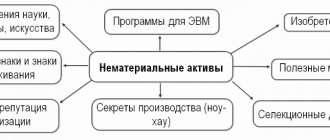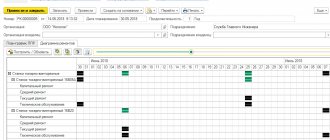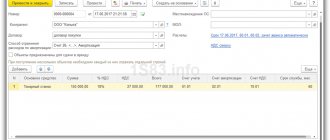Trade organizations regularly face the need to write off goods that have become unusable. First of all, these are shops and retail outlets selling perishable goods and products. However, write-off of unusable goods periodically has to be done in other areas of trade. It always starts with the inventory process. The documents drawn up based on its results are the basis for the formation of transactions and the inclusion in costs of the amounts of overdue goods in accounting and tax accounting.
Rules for writing off external and internal defects .
Legislative regulation and write-off features
During the inventory, goods that are subject to spoilage and expired are identified, as well as those on which an expiration date should be indicated, but in fact it is not. All these goods are classified as unusable and withdrawn from trade.
Write-off of goods that have become unusable is carried out on the basis of:
- Civil Code of the Russian Federation, art. 469, 470, 472;
- Federal Law-2300-1 dated 07/02/92
According to the norms of the Civil Code, the seller is obliged to offer the buyer only high-quality, usable goods. The sale of goods with an expired expiration date is prohibited, and this period must be set in such a way that the consumer can use the product before its expiration.
The Federal Law “On the Protection of Consumer Rights” requires the transfer to the buyer of goods that meet the mandatory requirements for it (Article 4), and also names goods on which the manufacturer must indicate an expiration date: medicines, household chemicals, cosmetics, perfumes, products (Article . 5).
Goods that are expired or do not have an expiration date indicated on the packaging are returned by the trading establishment to the supplier, destroyed or disposed of.
Federal Law No. 446 dated November 28, 2018 introduced a ban on the return of perishable goods of good quality (with a shelf life of less than a month). Requests for refunds or replacements for items subject to perishable deterioration have also been prohibited since the end of last year.
If the unusable product is not returned to the supplier, it is destroyed or disposed of. Without the participation of third parties, this can be done in relation to spoiled products or goods whose exact origin is unknown. In other cases, an expert assessment from a supervisory government agency (veterinary, merchandising, etc., depending on the type of product) is required.
Nuances of accounting for returnable packaging
Possible accounting difficulties are caused by the special status of returnable packaging: despite the fact that it is delivered to the buyer along with the goods, the ownership of it remains with the seller. An important point that determines accounting is the classification of reusable containers into different types of assets:
- material and production inventories;
- fixed assets.
Accounting for returnable packaging as stock
It is possible to register returnable containers as inventories in accounting if their useful life does not exceed 1 year or one operating cycle (if it exceeds 12 months).
To reflect transactions with such containers, the following are used:
- account 22 “Low value and wearable items”;
- subaccount 10.4 “Containers and packaging materials” - for warehouse and in-production storage and movement;
- subaccount 284 “Containers for goods” - mainly used by trading enterprises.
Accounting for returnable packaging as a main means of production
If the period of use of the container is greater than 12 months, and the cost is included in the limit established for the fixed assets, it falls under the definition of a fixed asset and should be recorded in the corresponding account 115 “Non-current assets”. Like all fixed assets, it is subject to depreciation and subsequent write-off.
Accounting for containers at the supplier
The supplier gives the container along with the goods, retaining ownership of it. In the receipt documents, a separate line is allocated to account for the cost of purchasing such containers; it is not added to the cost of other inventories, but is calculated at net realizable value. When it arrives with the goods, it will have a separate line on the delivery note or invoice.
Stock containers are recorded on account 41 “Containers under goods and empty,” and special containers are recorded on account 01 as fixed assets.
Accounting for containers from the buyer
The safety of returnable packaging and its return can be guaranteed by the text of the contract; in this case, no deposit is required, but sanctions for damage or loss of packaging are stipulated. This procedure will have to be taken into account in off-balance sheet account 002 “Inventory and materials accepted for safekeeping.”
The buyer who has paid a deposit for returnable packaging undertakes to return it to the seller in undamaged condition, after which he will receive the deposit amount back. This procedure is subject to accounting on balance sheet accounts 10 “Container” (if the goods arrived for your own use) and 41 “Container under the goods” (if resale is planned).
Example of posting dynamics of returnable packaging
Uchkuduk LLC entered into 2 agreements:
- Agreement for the supply of lemonade for its subsequent resale to the consumer. Lemonade in glass bottles is in plastic boxes of 6 pieces. The boxes are multi-return containers, for non-return of which there is a fine of 5,000 rubles. – reimbursement of the cost of boxes.
- Agreement for the supply of drinking water for employees of Uchkuduk LLC. Water cans are provided by the supplier on a returnable basis with a deposit of RUB 2,000.
Postings regarding containers under Contract 1, made by Uchkuduk LLC (buyer):
- debit 002 “Inventory and materials accepted for safekeeping” – 5,000 rubles. – plastic boxes in which lemonade is supplied are accepted;
- credit 002 – 5,000 rub. – plastic boxes are returned to the supplier.
Postings regarding containers under Contract 1, made by Zhazhda LLC (seller):
- debit 62 “Settlements with buyers and customers”, credit 41 “Container” - 5,000 rubles. – plastic boxes containing bottles of lemonade were handed over;
- debit 41 “Containers”, credit 62 “Settlements with buyers and customers” – 5,000 rubles. – plastic boxes were returned by the buyer.
Postings regarding containers under Contract 2, made by Uchkuduk LLC (buyer):
- debit 76 “Settlements with various debtors and creditors”, credit 51 “Settlement accounts” - 2,000 rubles. – a deposit has been paid for drinking water cans;
- debit 10 “Container”, credit 76 “Settlements with various debtors and creditors” - 2,000 rubles. – received canisters of drinking water;
- debit 76 “Settlements with various debtors and creditors”, credit 10 “Container” - 2,000 rubles - drinking water cans were returned to the supplier;
- debit 51 “Current accounts”, credit 76 “Settlements with various debtors and creditors” - 2,000 rubles. – deposit amount received for water canisters.
Postings regarding containers under Contract 2, made by Zhazhda LLC (seller):
- debit 51 “Current accounts”, credit 62 “Settlements with buyers and customers” – 2,000 rubles. – a deposit was accepted for drinking water cans;
- debit 62 “Settlements with buyers and customers”, credit 41 “Container” - 2,000 rubles. – canisters of drinking water were handed over to the buyer;
- debit 41 “Container”, credit 62 “Settlements with buyers and customers” – 2,000 rubles – drinking water cans were returned;
- debit 62 “Settlements with buyers and customers”, credit 51 “Settlement accounts” - 2,000 rubles. – the deposit amount for water canisters has been returned.
Write-off procedure
IMPORTANT! A sample write-off act from ConsultantPlus is available here
Inventory is carried out according to rules No. 49 of 06/13/95. Damaged goods are not included in the inventory, but are entered in the write-off act according to f. TORG-16 (15) or using an independently developed form reflected in the LNA.
When using unified forms, it is recommended to fill out both acts. TORG-15 documents the fact of damage, the TORG-16 act records the withdrawal from trade circulation and further actions in relation to the goods: recycling, destruction.
On a note! When disposed of, the product can still be processed and used; if destroyed, further processing is not possible.
The destruction of goods, in addition to the act signed by the commission and the conclusion, is formalized by a separate order. If damage or impossibility of further use of the goods is detected, explanations are taken from financially responsible persons. These actions allow us to identify the reason why the product has become unusable, for example:
- expiration date missed;
- damage due to the negligence of responsible persons;
- force majeure situation.
Depending on it, transactions are reflected in tax and accounting.
“Overdue” goods and the costs of their disposal can be taken into account without any problems in the NU, when reducing the tax base. This is stated in letters of the Ministry of Finance No. 03-03-06/1/53901 dated 08/23/17, No. 03-03-06/1/30409 dated 05/26/16 and a number of others. Likewise - spoilage within the limits of loss norms. The unsuitability of the goods, as a result of the negligence of the guilty persons, is compensated by these guilty persons in accordance with Chapter. 39 Labor Code of the Russian Federation. Losses of goods are first reflected in non-operating expenses (Tax Code of the Russian Federation, Art. 265), and then as non-operating income (Tax Code of the Russian Federation, Art. 250).
How to write off inventory items due to their unsuitability or shortage ?
The situation of damage during a natural disaster makes it possible to include the cost of damaged goods in expenses (Article 265-2-6), as well as the fact of failure to identify those responsible for the damage to goods (ibid., paragraph 5). This fact must be confirmed by a certificate of termination of the criminal case (letter 16 -15/065190 dated June 25, 2009, Federal Tax Service in Moscow).
When writing off unusable goods, account 94 is used, reflecting shortages and losses of inventory items.
How to display packaging costs correctly?
Expenses for disposable packaging can be displayed in accounting in several ways - it all depends on the type of activity of the enterprise.
In production, packaging is part of the material and production assets. To make accounting entries, account 10 “Materials” is used, as well as subaccount 4 “Containers and container materials”.
Subsequent cost accounting is determined by at what stage of production the product is placed in disposable containers:
- Packaging directly during the production process involves writing off expenses for inventories to the debit of account 20 (the amount is included in the cost of goods).
- Packaging of products after production indicates that the amount of costs will be written off to the debit of account 44.
Postings
Standard transactions for damage to goods will be as follows:
- 94/41 – damaged goods written off;
- 41/42 reversal – the trade margin is reversed;
- 96, 44/94 – allocation of costs due to the created reserve for product losses or to increase sales costs (within the limits of loss norms);
- 91-2, 73/94 - attribution of costs to the perpetrators or to other expenses if the culprit is not identified;
- 73/98 – if there is a difference between the price recorded for the goods and the amount collected from the culprit;
- 98/91-1 – attribution of this difference to other income.
If the volume of damaged goods exceeds natural loss, VAT is restored: 94/68.
Unusable goods with expired expiration dates are reflected in the following entries:
- 91, 90/41 – if the product is disposed of;
- 94/41 – if the goods are destroyed.
Example
Goods worth 6,000 rubles were transferred to the sales floor as a visual sample, incl. VAT 20%. A month later, the commission declared the goods damaged and decided to write them off. The act reflects the cost excluding VAT. No persons responsible for the damage have been identified; the goods deteriorated due to natural causes.
Postings:
- Dt 94 Kt 41 - 5000 rub.;
- Dt 44 Kt 94 - 5000 rub.
Let's use the conditions of the previous example, but determine that the goods were stored in a warehouse, and as a result of the negligence of the guilty party, they became unfit for use. The guilty person, who entered into a liability agreement with the organization, confirmed in an explanatory note his agreement to compensate for the damage in full.
Postings:
- Dt 94 Kt 41 - 5000 rub.;
- Dt 73 Kt 94 - 5000 rub.;
- Dt 50 Kt 73 - 5000 rub.
Here, the cost of the goods is attributed to the guilty parties, and then the debt is repaid by depositing cash into the cash register.
Is it necessary to restore VAT, previously accepted for deduction, when writing off goods with an expired shelf life or due to shortages, theft (theft), defects, fire, etc.?
Examples of postings for the 41st accounting account
Please note that all the examples of postings for the 41st account refer specifically to the sale of your own goods. Accounting for consignment goods is done in a different way.
- Dt 90.02.01 - Kt 41.02 A typical example of selling goods at retail.
- Dt 90.02.01 - Kt 41.01 But this is an example of the sale of goods in wholesale trade.
Of course, there are more entries in real documents. To make it clear to you what it actually looks like, below we have provided an example screenshot for the last transaction from the shown list.
As you can see, there are quite a lot of postings. Pay attention to the very first entry in the list, since this is where the goods are written off against sales. The remaining entries relate to the display of other operations necessary when selling goods.
Let's look at the opposite example, namely the purchase of goods. If the goods come from a supplier, then account 41 will already be in debit like this.
- Dt 41.02 - Kt 60.01 A typical example of posting when goods from a supplier arrives at a retail store.
A screenshot for this operation is given below. In this document, six types of items were purchased. The loan invoice is 60.01, about which you can read a separate article here.
You can watch more examples in our video course. We also recommend that you try to write down several transactions simply on paper to understand the principle. If you are interested in how this is done without a computer, read this article.
Briefly for the lazy
- Unusable goods are written off on the basis of a write-off commission act as a result of the inventory of goods. The legislator equates missing the product's expiration date to the impossibility of using a product.
- Unusable commodity mass is taken into account in account 94 or in account 91/2, if its disposal is possible. In tax accounting, expired goods can be included in expenses, as well as damage within the limits of loss norms.
- If the cost of damaged goods is attributed to the perpetrators who compensated for the damage, the amount is reflected in other income and expenses. In the event of natural disasters or if the court has not determined the person at fault, damaged goods may be reflected in other expenses.
Hello student
1.4.5. Accounting for barter transactions.
Barter (commodity exchange) are operations in which one party exchanges a certain amount of property (goods, fixed assets, etc.) for a corresponding amount of property of the other party.
A barter transaction is formalized by a corresponding agreement (contract). In a barter transaction, both parties to the agreement act simultaneously as both the seller and the recipient. A barter agreement by its legal nature is an exchange agreement, provided for by the Civil Code of the Republic of Kazakhstan dated December 27, 1994 in Article 235, paragraph 2, which states that the ownership of property that the owner has can be acquired by another person on the basis of a purchase and sale agreement , exchange, donation or other transaction for the alienation of this property.
In barter transactions, the conditions of equivalence of the exchanged property must be observed, which is achieved through the exchange at negotiated prices.
Mutual claims in barter transactions are regulated, as a rule, by additional supplies or a decrease in the supply of goods.
Resolution of the Cabinet of Ministers of the Republic of Kazakhstan dated July 19, 1995 No. 984 prohibited, from July 20, 1995, all economic entities of the Republic of Kazakhstan from carrying out export-import barter operations for all types of products and goods with countries near and far abroad. In this regard, we will consider the procedure for recording barter transactions carried out in the domestic market of the Republic of Kazakhstan. In accordance with the Law of the Republic of Kazakhstan “On taxes and other obligatory payments to the budget”, barter transactions for the payment of all taxes are considered as the sale of products, goods (works, services) at applicable prices.
The capitalization and write-off of the value of goods under barter transactions is generally carried out in the usual manner. A peculiarity of accounting for barter transactions is the mutual offset of receivables and payables under a barter transaction. The main accounting entries for accounting for barter transactions are presented in Table 9.
Table 9
Accounting for barter transactions
| No. n/n | Contents of business transactions | Document | Account correspondence | |
| Debit | Credit | |||
| 1. | Goods shipped under a barter agreement: | |||
| a) at negotiated prices | Invoice | 1280 | 6010 | |
| b) VAT | Invoice | 1280 | 3130 | |
| 2. | The cost of goods shipped via barter was written off at accounting (purchase) prices | Invoice | 7010 | 1330 |
| 3. | Goods received through barter at negotiated prices were accepted: | |||
| a) a car for business purposes | act of acceptance and transfer of fixed assets | 2410 | 3390 | |
| b) materials | invoice | 1310 | 3390 | |
| c) goods | invoice | 1330 | 3390 | |
| d) intangible assets | act of acceptance - transfer of intangible assets | 2730 | 3390 | |
| e) VAT on values accepted by barter | Invoice | 1420 | 3390 | |
| 4. | Barter payments have been offset | Reference | 3390 | 1280 |
1.5. Accounting for containers in trade
Most goods require packaging, i.e. packaging (stacking, installation) in certain containers, boxes, crates, containers. According to the Resolution of the Cabinet of Ministers of the Republic of Kazakhstan “On approval of the Regulations on the supply of products” dated June 19, 1992 No. 536, containers and packaging of products must comply with the requirements of standards or technical specifications, and contribute to the safety of products and goods during transportation. Suppliers are required to use reusable packaging, packaging equipment, packaging equipment, specialized containers and other types of reusable packaging, which are subject to return to the manufacturer (supplier) or delivery to packaging organizations (Article 470 of the Civil Code of the Republic of Kazakhstan). Thus, the container can be used once or used repeatedly (reusable container).
The cost of containers used to package products in the warehouse is reflected as follows:
Debit 7110 “Expenses for sales of products and provision of services”
Credit 1334 “Containers under goods and empty.”
At enterprises that buy and sell inventories in reusable containers, separate accounting must be provided for containers that:
— capitalized on the basis of shipping documents from suppliers;
— is not included in the supplier’s shipping documents and is capitalized on the basis of an act drawn up by the commission at the price of possible use;
- refers to fixed assets.
Containers arrive at enterprises along with inventory from suppliers and are accounted for on the basis of accompanying documents (waybills, invoices), in which they are highlighted as a separate line. Acceptance of containers is carried out on the basis of accompanying documents regarding quantity and quality. The release of empty containers (without goods) is documented in separate waybills, invoices and other expense documents.
Fight, damage, scrap of containers are documented in an act. The damage caused is recovered from the perpetrators in accordance with the established procedure.
Accounting for containers is carried out at storage locations by materially responsible persons in the commodity book or in warehouse accounting cards, entries in which are made on the basis of primary documents for the receipt or disposal of inventory. At certain times, financially responsible persons submit a material (commodity) report to the accounting department, which shows the receipt and disposal of containers for each document as separate items.
The container is taken into account:
— together with goods in wholesale and retail trade on account 1330 “Goods”;
— separately on account 1334 “Containers under goods and empty”;
- separately on account 2415 “Other fixed assets” if the reusable packaging corresponds to the characteristics of fixed assets.
Upon receipt of containers in accordance with accompanying documents from suppliers and other organizations, capitalization is made using the following entry:
Debit 1334 “Containers under goods and empty”
Loan 3310 “Short-term accounts payable to suppliers and contractors.”
If the container has the characteristics of fixed assets, then it is capitalized using the following entry:
Debit 2415 “Other fixed assets”
Loan 3310 “Short-term accounts payable to suppliers and contractors.”
Trading organizations for commodity transactions may have expenses, income and losses.
Packaging costs are costs associated with transportation, loading, unloading, repairs, etc.
Losses arise as a result of the mismanagement of materially responsible persons, resulting in damage, damage, scrap, and a decrease in the quality of the container.
An entity can receive income from containers, if the containers were received from suppliers free of charge, from the excess of the cost of the containers at delivery prices over the cost of the containers at discount prices.
Expenses for packaging are recorded on account 7110 “Expenses from the sale of products and provision of services”, and income - on account 6280 “Other income”.
Analytical accounting of containers is carried out by materially responsible persons, name, quantity, price.
Trade enterprises that sell inventory using reusable packaging that has deposit prices, which are set based on the actual cost of acquisition or procurement, are not subject to value added tax. The only exception is the shipment of returnable packaging, since, according to the Tax Code of the Republic of Kazakhstan, returnable packaging is packaging, the cost of which is not included in the cost of sales of the products sold in it and which is subject to return to the supplier on the terms and within the terms established by the contract for the supply of these products. If the container is not returned within the prescribed period, then such container is included in the sales turnover.
If the goods arrived in disposable packaging, which is included in the price of the goods or must be paid in addition to the cost of the goods, then this packaging, according to the Tax Code, is subject to VAT.
For reusable containers, a deposit is usually charged, allocated in the payment documents as a separate line, returned after the container is returned to the supplier, which is reflected in the supplier’s accounting records with the following entry:
Debit 1210 “Short-term receivables from buyers and customers”
Credit 1334 “Containers under goods and empty.”
The receipt of funds for containers at the deposit price is reflected by the entry:
Debit 1040 “Money in current bank accounts in tenge”
Loan 1210 “Short-term receivables from buyers and customers”
In the buyer’s accounting records are kept at the collateral value:
Debit 1334 “Containers under goods and empty”
Loan 3310 “Short-term accounts payable to suppliers and contractors.”
After transferring the deposit for the packaging to the supplier:
Debit 3310 “Short-term accounts payable to suppliers and contractors.”
Loan 1040 “Money in current bank accounts in tenge.”
If the container is returned to the supplier in good condition, the deposit is returned to the buyer in full:
Debit 1040 “Money in current bank accounts in tenge”
Credit 1334 “Containers under goods and empty.”
If the recipient of the package pays the seller at a price lower than the contract price, then the seller applies the difference to expenses:
Debit 7110 “Expenses for sales of products and provision of services”
Credit 1334 “Containers under goods and empty.”
For the return of containers to suppliers or packaging organizations, accounting entries must be made:
a) for the amount of income excluding VAT:
Debit 1210 “Short-term receivables from buyers and customers”
Credit 6280 “Other income”;
b) for the amount of VAT submitted:
Debit 1210 “Short-term receivables from buyers and customers”
Credit 3130 “Value added tax”;
c) writing off the cost of returned packaging:
Debit 7110 “Expenses for the sale of products and provision of services” Credit 1334 “Containers under the goods and empty”;
d) for writing off shortages, losses from damage to containers (scrap, broken, etc.): Debit 1630 “Other short-term assets”
Credit 1334 “Containers under goods and empty”;
e) for the posting of previously unaccounted for packaging and packaging received from suppliers without payment, as well as its surplus identified as a result of the inventory:
Debit 1334 “Containers under goods and empty”
Credit 6280 “Other income”;
f) for the costs of repairing containers carried out by a third party, according to the invoice presented for payment:
Debit 7110 “Expenses for sales of products and provision of services”
Debit 1420 “Value added tax”
Loan 3310 “Short-term accounts payable to suppliers and contractors”;
g) during internal movement of containers from one financially responsible person to another:
Debit 1334 “Containers under goods and empty” (warehouse 1) Credit 1334 “Containers under goods and empty” (warehouse 2).
1.6. Accounting for returned goods
Returning previously sold goods is a common phenomenon in the practice of many organizations. The return of goods by the buyer, like any business transaction carried out by an organization, must be properly documented and reflected in the accounting accounts.
If the goods previously transferred to the buyer are returned to the supplier on the grounds provided for by the Civil Code of the Republic of Kazakhstan or the contract, the buyer, in essence, reasonably refuses to fulfill the purchase and sale (supply) agreement, since, having transferred the goods to the buyer in violation of the requirements for quality and assortment , completeness, packaging, etc., the supplier did not properly fulfill its obligations under the contract. In this regard, the entries previously reflected in the accounting accounts for the sale of goods to the buyer must be clarified by making corrective entries.
All this will be reflected in the accounting accounts as follows:
Products shipped to customers:
a) the cost of shipped products is written off:
Debit 7010 “Cost of products sold and services provided”
Credit 1330 “Goods”
b) an invoice is presented to the buyer (for the agreed value) or income from the sale of products is accrued:
Debit 1210 “Short-term receivables from buyers and customers”
Loan 6010 “Income from the sale of finished products and services provided” - 684,300;
c) for the amount of value added tax on the contract value:
Debit 1210 “Short-term receivables from buyers and customers”
Credit 3130 “Value added tax”
d) for the amount of shipping costs:
Debit 7110 “Expenses for the sale of finished products and
services provided"
Credit 1040 “Money in current bank accounts in tenge”, e) payments received from the buyer for shipped products: Debit 1040 “Money in current bank accounts in tenge” Credit 1210 “Short-term receivables from buyers and customers”
If the buyer discovers a violation of quality requirements, an insufficient range of goods, the completeness or packaging is damaged, or a hidden defect is discovered, then the commission draws up a report and, if necessary, calls a representative of the supplier. Based on the act, a complaint is sent to the supplier, which is reflected on the invoices as follows:
Debit 1630 “Other short-term assets”
Loan 3310 “Short-term accounts payable
suppliers and contractors."
The supplier adjusts the volume of sales
goods reflected in accounting, on the basis of the invoice for the return of goods and the corresponding act.
If the goods have been accepted and capitalized, then after drawing up the act, all previous entries are reversed.
Previously made records on the shipment of products are reversed (using the “red reversal” method):
a) cost of shipped products:
Debit 7010 “Cost of products sold and services provided”
Credit 1330 “Goods”
b) contractual cost of shipped products: Debit 1210 “Short-term receivables from buyers and customers”
Loan 6010 “Income from the sale of finished products and services provided”
c) the amount of value added tax on the contract value: Debit 1210 “Short-term receivables from buyers and customers” Credit 3130 “Value added tax”
d) for the amount of shipping costs:
Debit 7110 “Expenses for sales of products and services provided”
Loan 1040 “Money in current bank accounts in tenge”
New products were shipped to replace the returned ones:
a) the cost of shipped products is written off:
Debit 7010 “Cost of products sold and services provided”
Credit 1330 "Products"
b) an invoice is presented to the buyer (for the agreed value) or income from the sale of products is accrued:
Debit 1210 “Short-term receivables from buyers and customers”
Loan 6010 “Income from sales of products and provision of services”
c) for the amount of value added tax on the contract value:
Debit 1210 “Short-term receivables from buyers and customers”
Credit 3130 “Value added tax”
d) for the amount of shipping costs:
Debit 7110 “Expenses for sales of products and provision of services”
Loan 1040 “Money in current bank accounts in tenge”
e) payments were received from the buyer for the shipped products: Debit 1040 “Money in current bank accounts in tenge” Credit 1210 “Short-term receivables from buyers and customers”
To confirm that the return of goods sold by the supplier was carried out in connection with justified claims related to improper fulfillment of its obligations, the supplier must have supporting documents. If the procedure for acceptance and documentation of goods by the buyer is established by the contract, documents confirming the identified discrepancies in quantity, quality, etc. must comply with the requirements of the contract. If the terms of the contract do not establish requirements for documenting acceptance, then acts are drawn up that are the legal basis for making claims to the supplier.
In the case of concluding an agreement for the purchase and sale of goods on credit, the buyer’s failure to fulfill the obligation to pay for the goods received gives the supplier grounds to demand the buyer return the goods or, in accordance with the agreement, pay fines (penalties, penalties).
Moreover, if, under the terms of the supply agreement, penalties are provided for violation of the terms of production, then the following accounting entry is made for the amount of fines (penalties, penalties) recognized by the supplier:
Debit 1630 “Other short-term assets” Credit 6280 “Other income”. Upon receipt of funds in compensation for penalties: Debit 1040 “Money in current bank accounts in tenge” Credit 1630 “Other short-term assets”
After the corresponding transactions for the return of goods are reflected in the accounting for the amount of the adjustment to the taxable turnover of VAT, the supplier issues an additional invoice in which the amount of the adjustment is indicated with a minus sign.
Reflection of goods return operations from suppliers:
- The actual cost of goods sold is written off:
Debit 7010 “Cost of products sold and services provided”
Credit 1330 “Goods”
- At the agreed price (excluding VAT);
Debit 1210 "Short-term receivables from buyers and customers"
Loan 6010 “Income from sales of products
and provision of services"
- For the amount of VAT on goods sold: Debit 1210 "Short-term receivables from buyers and customers"
Credit 3130 “Value added tax”
- For the contract price (excluding VAT) of returned goods of inadequate quality:
Debit 6020 “Return of sold products”
Credit 1210 "Short-term receivables from buyers and customers"
- For the amount of VAT on returned goods: Debit 3130 “Value added tax”
Credit 1210 "Short-term receivables from buyers and customers"
- For the actual cost of returned goods of inadequate quality:
Debit 7010 “Cost of products sold and services provided”
Credit 1330 “Goods”
- For the negotiated cost (excluding VAT) of transport services for the return of goods:
Debit 7210 “Administrative expenses”
Loan 3310 “Short-term accounts payable to suppliers and contractors.”
- For the amount of VAT according to the invoice of the trucking company for the return of goods:
Debit 1420 “Value added tax”
Loan 3310 “Short-term accounts payable to suppliers and contractors.”
If the buyer returns the goods to the supplier for other reasons, for example, due to the impossibility of selling them profitably, due to the lack of consumer demand, then the operation to return the goods is qualified by the supplier as the acquisition of this product and, accordingly, by the buyer - as a sale and is reflected in the accounting accounting of the original supplier in the manner prescribed for the acquisition of these goods. In this case, the original supplier duly fulfilled its obligations under the purchase and sale (supply) agreement, ownership of the goods transferred to the buyer, which entails recognition of the fact of sale for tax purposes.
1.7. Accounting for commodity losses and revaluation of goods
Transportation, storage and sale of goods in trade is accompanied in some cases by the formation of commodity losses. In trade practice, loss of goods can occur for both objective and subjective reasons. In this regard, it is customary to divide commodity losses into standardized and non-standardized. This division is important when writing off damage as a result of losses incurred.
Standardized losses are related to the physical and chemical properties of goods (natural loss, losses from broken goods in glassware, etc.), i.e. those that are objective in nature and therefore limit sizes (standards) are established on them. The norms for commodity losses are established by the state and published in the relevant regulatory documents. Losses of goods within the established norms are written off as the entity's expenses for the sale of goods.
Non-standardized losses arise, as a rule, as a result of mismanagement (breakage, scrap, damage to goods) or natural disasters. Writing off these losses requires identifying the causes and perpetrators of the losses.
Reducing commodity losses due to objective factors and the complete elimination of losses from mismanagement is one of the important problems, since these losses lead to a loss of turnover of an equivalent amount, respectively, and the income of the subject. If normalized commodity losses increase the subject’s expenses, then losses of goods due to the fault of specific persons are the immobilization of the subject’s assets until compensation for material damage is made. Therefore, in the conditions of market relations, the occurrence and write-off of such losses is unacceptable.









